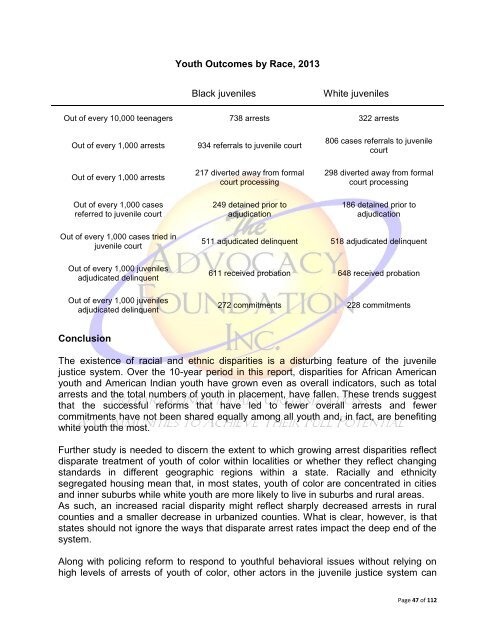Latino and Hispanic Youth in the Juvenile Justice System
Latino and Hispanic Youth in the Juvenile Justice System
Latino and Hispanic Youth in the Juvenile Justice System
You also want an ePaper? Increase the reach of your titles
YUMPU automatically turns print PDFs into web optimized ePapers that Google loves.
<strong>Youth</strong> Outcomes by Race, 2013<br />
Black juveniles<br />
White juveniles<br />
Out of every 10,000 teenagers 738 arrests 322 arrests<br />
Out of every 1,000 arrests<br />
934 referrals to juvenile court<br />
806 cases referrals to juvenile<br />
court<br />
Out of every 1,000 arrests<br />
217 diverted away from formal<br />
court process<strong>in</strong>g<br />
298 diverted away from formal<br />
court process<strong>in</strong>g<br />
Out of every 1,000 cases<br />
referred to juvenile court<br />
249 deta<strong>in</strong>ed prior to<br />
adjudication<br />
186 deta<strong>in</strong>ed prior to<br />
adjudication<br />
Out of every 1,000 cases tried <strong>in</strong><br />
juvenile court<br />
511 adjudicated del<strong>in</strong>quent 518 adjudicated del<strong>in</strong>quent<br />
Out of every 1,000 juveniles<br />
adjudicated del<strong>in</strong>quent<br />
611 received probation 648 received probation<br />
Out of every 1,000 juveniles<br />
adjudicated del<strong>in</strong>quent<br />
272 commitments 228 commitments<br />
Conclusion<br />
The existence of racial <strong>and</strong> ethnic disparities is a disturb<strong>in</strong>g feature of <strong>the</strong> juvenile<br />
justice system. Over <strong>the</strong> 10-year period <strong>in</strong> this report, disparities for African American<br />
youth <strong>and</strong> American Indian youth have grown even as overall <strong>in</strong>dicators, such as total<br />
arrests <strong>and</strong> <strong>the</strong> total numbers of youth <strong>in</strong> placement, have fallen. These trends suggest<br />
that <strong>the</strong> successful reforms that have led to fewer overall arrests <strong>and</strong> fewer<br />
commitments have not been shared equally among all youth <strong>and</strong>, <strong>in</strong> fact, are benefit<strong>in</strong>g<br />
white youth <strong>the</strong> most.<br />
Fur<strong>the</strong>r study is needed to discern <strong>the</strong> extent to which grow<strong>in</strong>g arrest disparities reflect<br />
disparate treatment of youth of color with<strong>in</strong> localities or whe<strong>the</strong>r <strong>the</strong>y reflect chang<strong>in</strong>g<br />
st<strong>and</strong>ards <strong>in</strong> different geographic regions with<strong>in</strong> a state. Racially <strong>and</strong> ethnicity<br />
segregated hous<strong>in</strong>g mean that, <strong>in</strong> most states, youth of color are concentrated <strong>in</strong> cities<br />
<strong>and</strong> <strong>in</strong>ner suburbs while white youth are more likely to live <strong>in</strong> suburbs <strong>and</strong> rural areas.<br />
As such, an <strong>in</strong>creased racial disparity might reflect sharply decreased arrests <strong>in</strong> rural<br />
counties <strong>and</strong> a smaller decrease <strong>in</strong> urbanized counties. What is clear, however, is that<br />
states should not ignore <strong>the</strong> ways that disparate arrest rates impact <strong>the</strong> deep end of <strong>the</strong><br />
system.<br />
Along with polic<strong>in</strong>g reform to respond to youthful behavioral issues without rely<strong>in</strong>g on<br />
high levels of arrests of youth of color, o<strong>the</strong>r actors <strong>in</strong> <strong>the</strong> juvenile justice system can<br />
Page 47 of 112

















